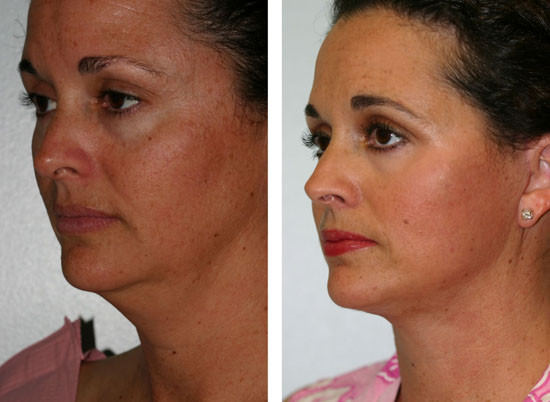
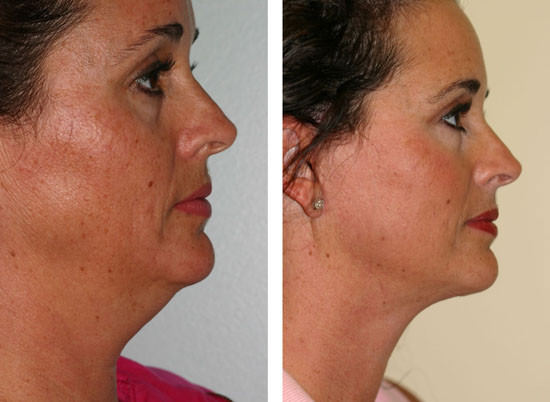
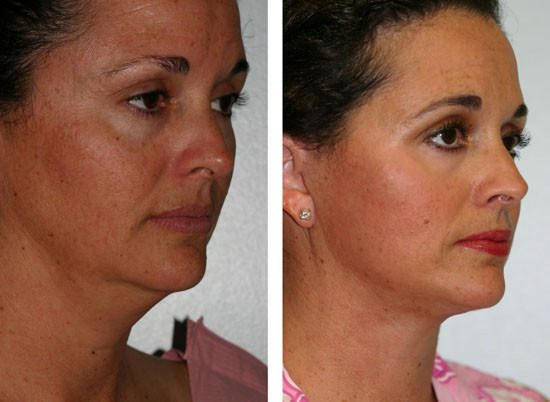
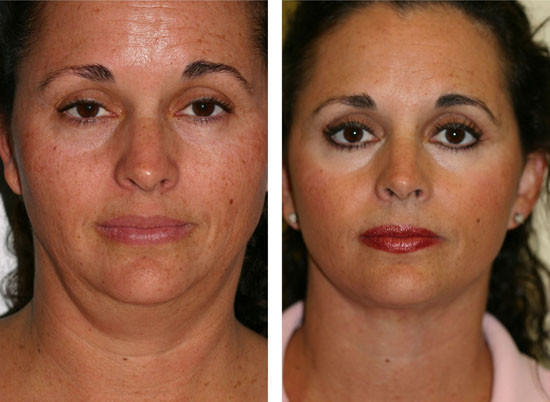
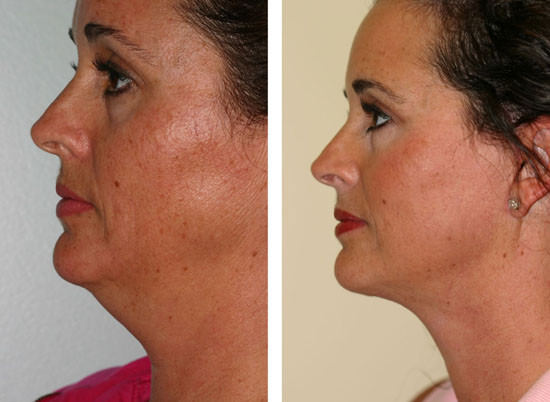
Facelift 1
The patient is a 42 year old woman who felt that her face was “going right into my neck”. She thought that this made her look older and with less facial definition. At her surgery, a mini-face lift was performed through hidden incisions in front of the ear and under the chin. After her procedure, the patient had a quick return to work and was able to also turn her head easily right after her surgery. She loved how the procedure gave her natural results but significant change including better definition of her face and neck and that she could get back to her life right away after the mini-face lift.
Minifacelifts are performed by making an inconspicuous incision in front of the ear but in its recesses and so can’t be seen after surgery. The incision goes around the earlobe but not up the back of the ear. The cheek and jowel can be completely lifted through this approach. As opposed to a minifacelift, in a standard face lift the incision in front of the ear is connected to an incision behind and up the back of the ear. A pocket is made from the incision downward toward the lower neck and this space is made over the large neck muscle that turns the head. SO one big difference between a mini-face lift and a standard face lift is that in a standard face lift the neck is stiff for about two weeks after the surgery. That’s not the case with a mini-face lift because the space under the skin is made only over the cheek and directly over the jawline and into the neck, not over the neck turning muscle. Therefore, patients have a much quicker recovery after a mini-facelift and a appear more natural in their head movements right after the procedure.
Through these small inconspicuous incisions the entire face can be lifted to the same extent as with a standard face lift (also known as a full face lift) because the cheek and jowel can both be lifted to the same extent. The skin of the face can also be treated to the same extent when comparing both techniques and that can be seen in this patient with the smoothing of the “parallel lines”. These are the lines and folds that run parallel to each other and also run parallel to the deep folds that run from the side of the nose, down past the corner of the mouth and toward the jaw line that can be seen on the side-view photographs of this patient. The parallel lines run just outside this deep fold and represent loose skin. As can be seen from the side views of this patient these lines have been erased by the minifacelift.
What differentiates standard and mini-face lifts is their ability to affect the neck and that underscores the importance of seeking consultation with an experienced plastic surgeon who does a lot of facelifts and is well versed in the different techniques available to help in facial rejuvenation. In general, the procedure that is aimed at the most improvement is often the safest, most effective and long lasting choice. Facelifts may be repeated but we want to do them with better results and less often. That is why it is better to spend more time during the procedure and get the most from that effort.
The mini-face lift technique is able to lift the skin and fat of the face. This results in a happier looking face rather than one that is sad appearing because drooping features make us look sad. Lifting the cheek towards the eyelid helped to smooth the depressed space between the cheek and lid and so make the patient appear youthful and vigorous. In other words, mini and standard face lifts can give significant improvements to the midface, bringing harmony to the area between the eyes and the lips.
This mini-face lift was combined with a neck lift and fat was removed in the neck from above and beneath the neck muscles and the muscles resuspended to create a beautiful neck angle where before there was only a straight line down towards the chest. This has the effect of creating beauty and youth in the neck itself and also serves to further to make a visual separation between the neck and face. This further reinforces the beauty of the face, defining the face and creating sharper angles over the jaw line that harmonize with the other beautiful angles of the face including the cheek and the newly softened cheek folds and bring attention to the sharp angles of the jaw near the earlobe. Sharpening and creating these angles also harmonizes with the sharp planes of the nose and makes the nose appear more beautiful.
